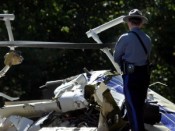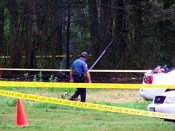By ROHAN SULLIVAN and KRISTEN GELINEAU, Associated Press
SYDNEY – Australian investigators on Thursday identified the source of an oil leak that caused a superjumbo engine to blow apart in mid air last month, and said a suspected manufacturing defect in the Rolls-Royce engine was to blame.
They warned airlines the potential flaw could cause engine failure.
The Australian Transport Safety Bureau recommended the three airlines that use Rolls-Royce’s massive Trent 900 engines on their A380s go back and conduct more checks now that it had pinpointed the problem area. Three airlines fly a total of 20 the Airbus planes.
Earlier warnings blamed an oil leak for a fire and subsequent chain of failures that sent heavy parts flying off an engine on a Qantas A380 shortly after it took off from Singapore on Nov. 4, the most serious safety problem for the world’s largest and newest jetliner.
The ATSB, which is leading the international investigation into the Qantas breakup, added some specifics on Thursday, saying a section of an oil tube that connects the high-pressure and intermediate-pressure bearing structures of the engine was the danger area.
“The problem relates to the potential for misaligned oil pipe counter-boring, which could lead to fatigue cracking, oil leakage and potential engine failure from an oil fire,” the ATSB said in a brief statement.
It called the problem “a potential manufacturing defect.”
Counterboring involves placing a larger hole over a smaller hole to make room for a seal. The ATSB said a misalignment of those holes had produced a thinning of the oil pipe wall and fatigue cracks. That could have led to oil leaking into a section of the engine containing extremely hot gas — a mixture of burned fuel and air. If oil comes into contact with the hot gas, it will burn.
“It is a design error and obviously a major one,” said Peter Marosszeky, a jetliner maintenance expert at the University of New South Wales.
Rolls-Royce had no comment Thursday morning.
The ATSB recommended close inspections of all Trent 900 engines to look for signs of the problem. Any engines that display such signs should be removed from service, it said.
In response to that recommendation, Rolls-Royce, affected airlines and other safety regulators were taking action to ensure the A380s involved were safe, the ATSB statement said.
The three airlines, Qantas, Singapore Airlines and Germany’s Lufthansa, conducted extensive checks of their Trent 900 engines and modified some parts in compliance with a Nov. 11 directive from the European Aviation Safety Agency. That order was to look for oil leaks in the same section of the engine, but did not mention a potential source.
On Thursday, the agency said it had no immediate plans to change that directive following the ATSB’s recommendations.
“We believe the safety of the engines is ensured by our previous (Nov. 11) airworthiness directive, namely the engine inspections,” spokesman Dominique Fouda said. “But if there are additional findings in the next several days, we reserve the right to change that directive.”
Regulators have said preliminary investigations show an oil fire broke out in the section of the Qantas engine that houses the turbines, which are spun at great speeds by combusting jet fuel. An oil pump and network of tubes lubricate and cool the turbines.
Experts say the fire could have caused the rotor to which the turbine blades are attached to expand, bringing the blades into contact with the casing that encloses the engine. Part of a shattered turbine disc was found in the wreckage of the engine, and another part flew off in the disintegration and hasn’t been recovered, the ATSB said.
Qantas, which grounded its six A380s for more than three weeks after the blowout, said Thursday it would conduct one-time checks on its superjumbos. Spokesman Simon Rushton said the inspections were not expected to take long, or disrupt service.
Qantas replaced 16 Trent 900s before putting just two of its A380s back into the skies five days ago. The others are still undergoing tests.
“After discussions with the Australian Transport and Safety Bureau and Rolls-Royce, it was decided it was prudent to conduct further inspections of engine components, although there is no immediate risk to flight safety,” Qantas said in a statement.
The ATSB finding strengthens Qantas CEO Alan Joyce’s stated belief the engine blowout was caused by a manufacturing problem, not a maintenance issue for which the airline could bear responsibility. Rolls-Royce has remained largely silent about the issue since it happened, and the London-based company’s share price has seesawed. Rolls-Royce shares were down 1.4 percent at 610 pence in the first hour of trading on the London Stock Exchange on Thursday.
Qantas said Thursday it filed a statement of claim in a federal court that will allow it to pursue possible legal action against Rolls-Royce if it isn’t satisfied with a compensation offer from the engine manufacturer.
“Today’s action allows Qantas to keep all options available to the company to recover losses, as a result of the grounding of the A380 fleet and the operational constraints currently imposed on A380 services,” Joyce said in the statement. He has refused to specify how much compensation the airline wants.
On Nov. 12, the company said its full-year earnings would be “slightly lower than previously guided” because of the problem with the engines. In July, it had forecast underlying profits would grow by 4-5 percent compared to 2009.
John Page, an aircraft designer and senior lecturer in aerospace engineering at the University of New South Wales, said one possible explanation for a misalignment of the oil tubes was a programming error in computers used in the manufacturing process.
“The problem with it is if there is an error in the coding of the machining, then (to) some extent it’s not as obvious — because nobody’s actually doing it by hand,” he said. “As designs become more and more automated, people are expecting more perfection. It’s much closer to perfection — it just ain’t perfect.”
The ATSB is due to publish its preliminary report into the Qantas incident on Friday.
Chief commissioner Martin Dolan said it pre-empted the report with Thursday’s safety recommendation because it realized only on Wednesday in discussions with Rolls-Royce the significance of the counterboring issue.
“We considered it was a sufficiently significant safety issue that we should immediately release it to parties who were operating with these engines,” Dolan told The Associated Press.
Singapore Airlines has 11 superjumbos which use Trent 900 engines and Lufthansa has three.
Singapore Airlines said Thursday it is conducting new checks of its engines. The airline “is complying with the recommendations and carrying out the new inspections, alongside other inspections recommended by Rolls-Royce and included in the directives from the European Aviation Safety Agency,” it said in a statement.
___
Associated Press writers Rod McGuirk in Canberra, Australia, and Slobodan Lekic in Brussels contributed to this report.



